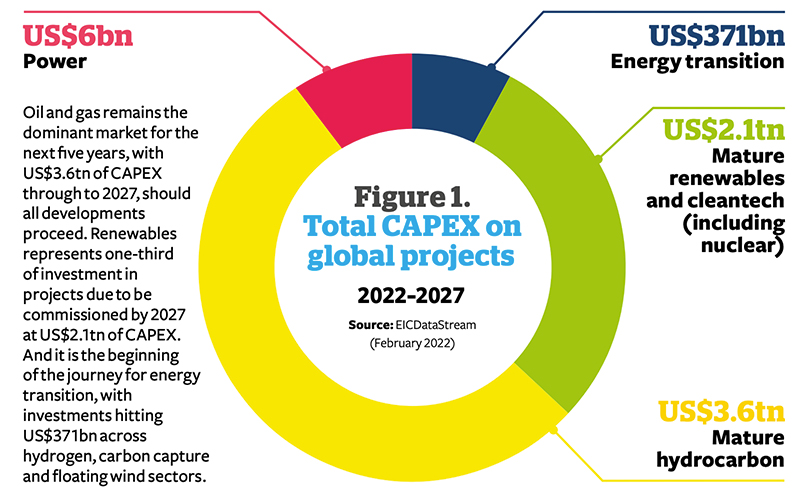Are the opportunities out of reach?
With a spike in demand and higher prices providing energy companies with the means for expansion across both new and traditional energy segments, Jonathan Dyble asks: is the current energy landscape equipped to support major growth ambitions?

While 2021 once again proved that predictions must come with disclaimers, thanks to even more unanticipated events, there is at least some cautious optimism in 2022.
As economies continue to rebound from two years of pandemic-induced hardships, successful vaccination programmes and the seemingly less lethal Omicron variant of COVID-19 have boosted confidence as the world once again emerges from uncertainty.
Right now, the global outlook is improving. The International Monetary Fund predicts that global growth will reach 4.4% this year, while the Organization for Economic Cooperation and Development revealed that inflation among its 38 states exceeded 5% at the end of 2021.
We are currently witnessing an inflationary boom, with strong growth plus a push on prices – a scenario that has seen the energy industry begin to broadly benefit from recent spikes in energy prices.
“Demand for energy is increasing as we emerge from the COVID-19 pandemic,” explains John Kent, Chief of Energy Transition at Kent plc.
“This is particularly true for transportation fuels, and also hydrocarbon-based power generation in Europe, as wind volumes have been lower in recent months and geopolitical tensions are at a recent high due to the conflict in Ukraine.
“Additionally, under-investment in new assets in recent years is fuelling the increase in oil and gas prices. OPEC Plus also maintained a largely cohesive position in recent months on the back of increased cashflow from higher energy prices.”
Opportunities aplenty
Indeed, the situation that has emerged has been something of a perfect storm – one that presents significant opportunities for energy firms.
Global oil prices are now rapidly approaching US$100 per barrel for the first time since 2014, providing industry players with the cashflow they need to begin to truly expand investment, enhance research and development efforts, and accelerate project implementation.
We are currently witnessing an inflationary boom with strong growth plus a push on prices – a scenario that has seen the energy industry begin to broadly benefit from recent spikes in energy prices
EIC data shows that traditional oil and gas will remain the largest market for the next five years (see Figure 1). However, for Neil Golding, Director of Market Intelligence at the EIC, significant sums may be leveraged from this booming sector to allow investments in other markets to blossom.
“We’ll see investment in renewables,” he says. “Wind and solar offer the potential for low costs, and they’ll be hugely important to ensuring energy firms align with their net-zero targets.
“I think we’ll see ramping up of activity in the Middle East, both in terms of conventional hydrocarbons technologies but also potentially in the hydrogen arena – and certainly in carbon capture.”
In terms of other regions, Golding anticipates Europe leveraging the inflationary boom to become more self-sufficient in meeting energy demand, while also forecasting huge growth in offshore wind in the Asia Pacific region, driven by China.
Indeed, it seems likely that energy firms will take advantage of the boom in oil prices to facilitate their investments in areas such as these.
“Many operators are experiencing buoyant cash positions and can see a clear path to continued strong earnings,” explains Kent.
“Energy firms are cognisant that there is a development window now open before the world is likely to see a dropping demand in hydrocarbons. I believe regions with lower production cost and lower carbon footprints are also likely to see stronger longer-term returns, and getting ahead of this with proactive planning now is likely to reap long-term reward.”
Oil-driven renewable investment
Several countries and companies have committed to investment in renewables in recent months thanks to the confidence provided by an inflationary boom, underpinned by high oil prices:
September 2021: TotalEnergies revealed it would leverage high oil prices as a means of buying back US$1.5bn in shares so that it could boost investment in renewable energy projects
October 2021: The UAE earmarked US$163.4bn for investment in renewables by 2050. Qatar Petroleum also changed its name to Qatar Energy to signal its enhanced focus on renewables
December 2021: Saudi Arabia committed to generating 50% of its electricity from renewables by 2030, committing US$101.3bn to renewables investments by the end of the decade
February 2022: bp stated it would ensure low-carbon energy would account for 40% of total spending by 2025 and 50% by 2030, shortly after announcing its highest annual profit in eight years
Growth potential: attainable or unviable?
There are, however, question marks on whether energy firms will be able to capitalise on the inflationary boom to the extent that they may want to.
Supply chain constraints will be a major factor here. Prevalent in all sectors globally, they are perhaps the most significant barrier preventing many markets from taking off as we would otherwise expect.
Here, Golding points to the offshore wind market as an example. “Worldwide, we’re expecting to see between 4,000 and 4,500 turbines installed offshore between now and the end of 2024. From 2025 to 2030, to hit the targets on the announced projects, we will have to install anything between 27,000 and 40,000 turbines.

“We’re looking at potentially 6,000 turbines a year that need to be installed over that period, but we just simply don’t have the vessels or fabrication capacity to achieve those numbers right now.”
This problem is being exacerbated by political challenges. In the UK, for example, Brexit is continuing to contribute to a delay in goods getting into the country.
Meanwhile, skills shortages present an equally significant challenge. For new projects to accelerate, a dramatic increase in industry specialists is required, yet the current talent pool is unable to fully meet such demands.
“Personally, we’re finding attracting and recruiting people to work in the energy industry to be a significant challenge, and we’re hearing the same from our member companies,” Golding explains, providing the EIC’s take.
These thoughts are echoed by David Clark, CEO of Vysus Group – a leading engineering and technical consultancy.
“We will very quickly see a skills shortage in the energy sector, with many people having left the sector for good,” Clark states, recounting the impact of more challenging years. “Coupled with the supply chain constraints and cost inflation in key core components such as steel and cement, the delivery of new projects will become increasingly challenging.”
We’ll see more activity in oil and gas; we’ll see more activity in offshore wind; we’ll see projects really moving forward in the carbon capture and hydrogen sectors Neil Golding, Director of Market Intelligence, EIC
Top global markets in energy transition
North America, Europe and Australasia lead the way in terms of the number of new project announcements, with the US, Australia, UK, Chile and Germany on top.
The top 5 countries leading in CAPEX spend (US$m) through to 2030 on known developments are Australia, the US, Brazil, China and the UK.
Source: EICDataStream (February 2022)
Industry remains upbeat
Many industry players are working closely with universities to show the benefits of carbon capture and clean tech in order to attract new talent, while Kent points to strong anticipated growth in low-carbon and renewable energies.
“This year will be better than the last two years,” Golding adds. “We’ll see more activity in oil and gas; we’ll see more activity in offshore wind; we’ll see projects really moving forward in the carbon capture and hydrogen sectors. And you will continue to see growth in the commoditised renewables sector as well.
“There’s just that one big question mark,” he finishes. “How far will energy companies be able to capitalise on this window of opportunity?”
Image credit | Shutterstock






Follow us
Advertise
Free e-Newsletter